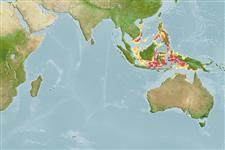>
Ovalentaria/misc (Various families in series Ovalentaria) >
Pseudochromidae (Dottybacks) > Pseudochrominae
Etymology: Manonichthys: Name is a combination of Greek manon which is a kind of sponge, and ichthys for fish, referring to the sponge-dwelling behaviour of the species under this genus; winterbottomi: Named for Dr. Richard Winterbottom.
Eponymy: Dr Richard ‘Rick’ Winterbottom (d: 1944) is an evolutionary biologist and ichthyologist who was born in Zambia. [...] (Ref. 128868), visit book page.
More on author: Gill.
Environment: milieu / climate zone / depth range / distribution range
Écologie
marin récifal; profondeur 8 - 35 m (Ref. 81967). Tropical
Western Pacific: Philippines.
Taille / Poids / Âge
Maturity: Lm ? range ? - ? cm
Max length : 7.0 cm SL mâle / non sexé; (Ref. 81967)
Description synthétique
Clés d'identification | Morphologie | Morphométrie
Épines dorsales (Total) : 3; Rayons mous dorsaux (Total) : 27 - 29; Épines anales: 3; Rayons mous anaux: 15 - 16; Vertèbres: 26. This species is distinct in possessing the following characters: pectoral fins at least partly black; some upper opercular scales are ctenoid; 13-17 horizontal scale rows above the anal-fin origin; 16 circumpeduncular scales (Ref. 74994, 81967).
Collected around corals and Millepora and usually enters the cavities of 'blue tubular sponges' (Ref. 81967). Solitary (Ref 90102).
Life cycle and mating behavior
Maturité | Reproduction | Frai | Œufs | Fécondité | Larves
Gill, A.C., 2004. Revision of the Indo-Pacific dottyback fish subfamily Pseudochrominae (Perciformes: Pseudochromidae). Smith. Monogr. (1):1-213. (Ref. 81967)
Statut dans la liste rouge de l'IUCN (Ref. 130435: Version 2024-2)
Menace pour l'homme
Harmless
Utilisations par l'homme
Outils
Articles particuliers
Télécharger en XML
Sources Internet
Estimates based on models
Phylogenetic diversity index (Ref.
82804): PD
50 = 0.5078 [Uniqueness, from 0.5 = low to 2.0 = high].
Bayesian length-weight: a=0.00501 (0.00193 - 0.01299), b=3.10 (2.88 - 3.32), in cm total length, based on LWR estimates for this (Sub)family-body shape (Ref.
93245).
Niveau trophique (Ref.
69278): 3.6 ±0.5 se; based on size and trophs of closest relatives
Fishing Vulnerability (Ref.
59153): Low vulnerability (10 of 100).
